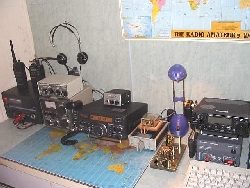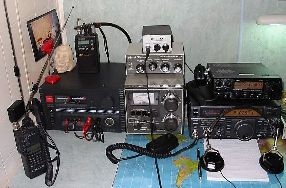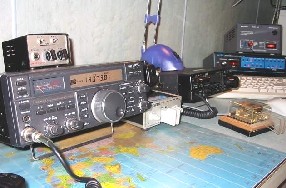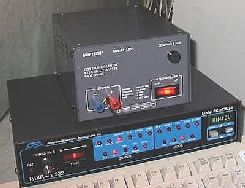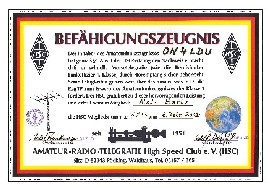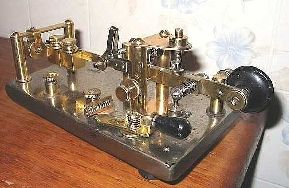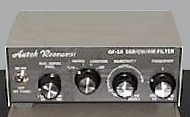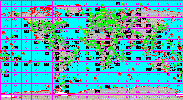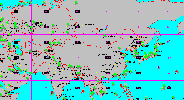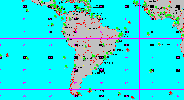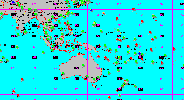|
About Me Biography & equipment Hi ! I am born in 1965, married with a child, and I was not involved in hamradio activities until a few years ago. I received my full privilege license in Belgium end 1997. I worked 2 years in SSB but I am now fully involved in CW activities, hunting DX at high speed... So if you listen to my call there are some chances that you will also hear one of the most wanted DX near my QRG. Don't miss it ! My QTH is located at Arlon in the far south of Belgium, QTH Locator JN29VQ. You can reach me on various ways, the easiest being through the packet network : [email protected] or using your mail system. You can write me in French, Italian or English. I present you below my radio shack :
My shack is constituted of the following equipment : - Yaesu FT-840 transceiver for HF bands from 1.8 to 30 MHz - Yaesu portable transceiver for VHF bands (2m) and accessing to clusters - Autek QF-1A external audio filter (the box just above the SWR meter) - TNC for packet - Computer running Windows - Vibroplex keyers for CW - SWR meter - Desktop computer with 17" display and sound card - Ham software DX4WIN, DXAtlas, EZGram, CWGet, W6EL and more. The HF transceiver is completed with various filters and DSP software to extract the weakest signals when DXing in high speed CW. In a very near future all this installation will be replaced by a high-end transceiver including DSP on the IF-stage, a double VFO and the best Collins filters in order to be ready to work pile-ups and QRP stations in the best conditions. According my readings and comparisons, the YAESU FT-1000 MARK V meet all my needs and is currently my master choice, one step ahead from any other Kenwood or Icom. In the meantime I bought a Kenwood TS-570D that exceeds by far the performances of my FT-840 due to its numerous filters and memories. I appreciate much this new RTX, even if it is less nervous in SSB than my old rig. Read a complete review with pictures and sound on LUXORION website. At last, some years ago I was honored to be incorporated in the famous german High Speed CW club, HSC.e.V. Here is their plaque :
The Autek QF-1A I would like to present you the famous Autek QF-1A audio filter. This is small external device able to process different signals from CW, SSB, SSTV and more in a much better way than any DSP. Not complex in its design it comes with a serie of four control knobs that require however to read the manuel prior any use to optimize its functionalities. Here are the four pages of its manual. Click on each page to load the full and readable document (1275 x 1650 pixels, 90 KB each). More information about hams equipment, propagation and QSLing: My scores The Cushcraft R7 I use is an excellent vertical antenna. As only proof of its performances, in one weekend when propagation was good, I have been able to work 38 CQ zones without much efforts, excepting to be QRV all day long. Using such an antenna there is no problem to get e.g.the 48 hours 100 DXCC award but I am not a "paper chaser". I have also built a vertical cut at l/2, 20m long made of aluminum, to work during the minimum of solar cycle on the lower bands. On these bands results are already better than using my 100m longwire or my R7. Here is a summary of my DXCC scores got since end 1997. If I am not an award hunter I will be however very happy when I will achieve the all list of 335 DXCC entities in both CW and SSB modes. But as long as Andaman (VU4), Laccadive (VU7) and other Desecheo islands (KP5) will be inaccessible, there is not the least chance that my dream comes true, Hi ! Check my logbooks online: Among the current difficulties, beside the most wanted DX that I am hunting, I just achieved the African continent with ST0F. I am now in search of all these small islands lost in the Pacific ocean, some more Antarctica bases and stations to name a few. Refer to my QSL page to see some among the rarest entities that I worked.
Working far DX or the "most wanted" requires some knowledges of propagation and the way that the Sun activity interacts with the earth ionosphere. All advanced hams know for example that a far DX can only be worked when the Sun is well above that country (local noon) and that it will be hard or impossible to work at local midnight. In fact I apply a simple rule : excepting DXpeditions who usually work 24 hours a day and on most frequencies and modes, to work a DX I follow the Sun position, beginning with UA0, then moving to JA, VK, VU, ZS, PY, W1, W6 to end with the Pacific twelfe hours later. Of course the study of the propagation conditions is mandatory working DX stations on HF bands, and W6ELprop software provides me a valuable assistance. Complementary, I try to understand the behaviour of hams on the air, as many of them work always on the same frequencies and time (for example on week days on 21210 kHz between 0900-1030z). Once you have found some periodic activity, be there at the right time on the right frequency and I bet that you will work that DX very easy. With this objective in mind the assistance of clusters like EA7URC is became very useful and I can no more bypass this tool during my activities, at one exception, when I work on portable or mobile. LX/ON4LDU Living near the western border of Luxembourg, occasionnally I work abroad with the less common callsign LX/ON4LDU. If you are interested in this entity we can arrange a sked to work on CW, SSB on HF or VHF bands from LX. Send me only an email to sked this QSO.
My favorate links LUXORION, an educative website devoted to amateur astronomy and hamradio, managed by LX3SKY, T.Lombry. DXCluster - QRZ - Yahoo - Garant Funk - Cushcraft. Back to |
|||||||||||||||||||||||||||||||||||||||||||||||||||||||||||||||||||||||||||||||||||||||||||||||||
